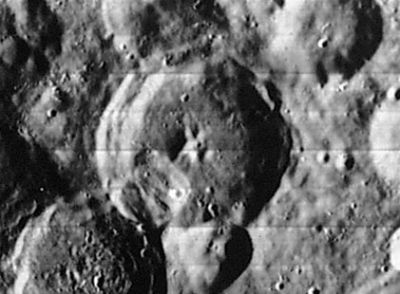Miller
Contents
Miller
| Lat: 39.3°S, Long: 0.8°E, Diam: 61 km, Depth: 3.55 km, Rükl: 65 |
Images
LPOD Photo Gallery Lunar Orbiter Images Apollo Images
Maps
(LAC zone 112B4) LAC map Geologic map
Description
Description: Elger
(IAU Directions) MILLER.--One of a group of three moderately large ring-plains, of which Nasireddin is a member, near the central meridian in S. latitude 39 deg. Its massive border rises nearly 11,000 feet above the floor, on which stands a central peak. Miller is about 36 miles in diameter.
Description: Wikipedia
Additional Information
- Depth data from Kurt Fisher database
- Westfall, 2000: 3.55 km
- Viscardy, 1985: 3.5 km
- Cherrington, 1969: 2.28 km
- Central peak composition: A & GNTA1 (Tompkins & Pieters, 1999)
Nomenclature
- Named for William Allen Miller FRS (December 17, 1817 – September 30, 1870), a British scientist. Although primarily a chemist, the scientific contributions for which Miller is mainly remembered today are in spectroscopy and astrochemistry, new fields in his time.
- On Fauth's 1932 sectional map of "Hörbiger" (Deslandres) -- reproduced on page 269 of Ashbrook (in a chapter reprinted from Sky and Telescope, October 1965, p. 202) -- the name Miller is assigned to the IAU's Lexell A (a 34 km crater to the northwest of the IAU's Miller). In addition to Miller, all satellite feature letters given by Fauth in the upper left quadrant of this map differ from the current IAU names (although they agree elsewhere). - Jim Mosher
- It might be intereresting to add Dayton Clarence Miller (1866-1941), American physicist, astronomer, acoustician, and accomplished amateur flautist.- DannyCaes Mar 21, 2015
- Also very interesting to know: Stanley Lloyd Miller (1930-2007), Jewish-American chemist who made landmark experiments in the origin of life (the Urey-Miller experiment).- DannyCaes Mar 23, 2015
LPOD Articles
Bibliography
Dayton C. Miller in the Sourcebook Project (William R. Corliss)
- In Mysterious Universe, a handbook of astronomical anomalies (1979) :
- Page 660: Motion of the Earth through the Ether (Science, 1925).
- Page 661: Ether Drift Experiments (Dayton C. Miller, Nature, 1926).
- Page 663: The Ether Drift (Science, 1929).
- Page 664: Repetition of the Michelson-Morley Experiment (Nature, 1931).
- Page 665: The Ether-Drift Experiment and the Determination of the Absolute Motion of the Earth (Dayton C. Miller, Nature, 1934).
- Page 669: Gardner's Hypothesis and the Michelson-Morley Experiment (J.L.Synge, Nature, 1952).
And there's also:
A. M. Miller
- Page 310: The Cumberland Falls Meteorite (Geo.P.Merrill, Science, 1919).
And... Joseph Miller
- Page 593: New Light on Quasars: Unraveling the Mystery of BL Lacertae (William D. Metz, Science, 1978).
